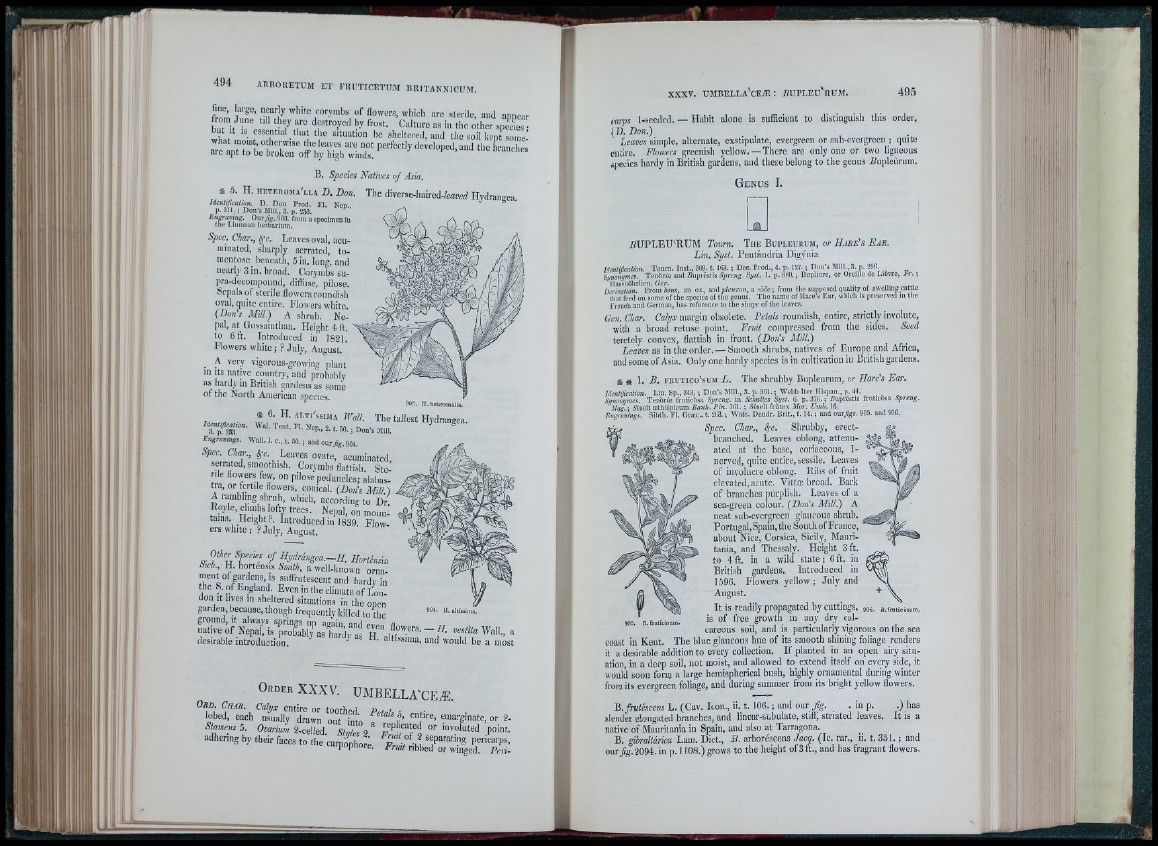
ta e , large, nearly wliite corymbs of floivers, which are sterile, and apnear
fr om June till they are destroyed by frost. Culture as in the ¿ h e r s p S Z
wtoit n i o - ■ ' f t f t sheltered, and the soil kept some-’
a t ' ‘; T t o ? “ h £ £ r „ 7 by m3 i™ . £ “eveIoped,and the branches
B. Species Natives of Asia.
at S. II. i i e t e r o m a 'l l j B . Don. The diverse-haired-feaw« Hydraneea
Idcn/(/ica(ion. D. Don Prod. Fl. Nod
p. 211. ; Don’s Mill., 3. p. 2^ . ’
Engraving. Ourjig. 903. from a specimen in
tne Linnæan herbarium.
Spec. C/iar., ^-c. Leaves oval, acu-
niinatcd, sharply serrated, tomentose
beneath, 5 in. long, and
nearly 3 in. broad. Corymbs su-
pra-decoinpound, diffuse, pilose,
bepals ol sterile flowers roundish
oval, quite entire. Flowers wliite.
(Doris MUl.) A shrub. Nepal,
a ( Gossainthan, Height 4 ft.
to 6 ft. Introduced in 1821.
Flowers white ; ? July, August.
^ A very vigorous-growing plant
in its native country, and probably
as hardy in British gardens as some
of the North American species.
905. H. hetproinilla.
« , W ■■ W ''“'"'reiMA WaU. The tallest Hydrangea.
50-1 Do n ', Mill. ' “
Engravmgs. Wnll. 1. c„ t . 50. ; and our flg. 904.
free. Char., §•». Leaves ovate, acuminated,
serrated, smoothish. Corymbs flattish. Ste-
rfle flowers few, on pilose peduncles; alahas-
tra, or fertile flowers, conical. (Don's MUl.)
A rambling shrub, which, according to Dra
Royle, climbs lofty trees. Nepal, on mountains.
Height?. Introduced in 1839 Flow
ers white ; ? July, August.
Other frecks of Ifrdrangea.—H, Hortênsia
Sieb., H. hortensis Smith, a well-known orna-
nnent of gardens, IS snffrutescent and hardy in
the S of England. Even in the climate o f Lon-
don It lives in sheltered situations in the open
garden because, though frequently killed to the
904. H. alUssima,
nLtive i f ^ > X s T c o b f tw 7 a ^ f ? " d y as ®H “ f t f t * “ Wail., a
desirable introduction. ’ and would be a most
O r d e r XXXV. UMBELLA'CErE.
lobed, each m fta lly " ? ?™ Z ^ t o t ’o emarginate, or 2-
Staniens S. Ovarium 2-celled. Styles » £ f t T o ""'P'toed point,
adhering by their faces to the carpopho;;. t e r i b b e 7 : r Z | e ? ' ' " S
rarps 1-seedcd. — Habit alone is sufficient to distinguish this order.
(X). Don)
Leaves simple, alternate, exstipulate, evergreen or sub-evergreen ; quite
entire. Floivers greenish yellow. — There are only one or two ligneous
species hardy in British gardens, and these belong to the genus JSiipleurura.
G e n u s I.
RU PL EU 'RUM Tourn. T h e B u p l e ü e u m , or H a r e ’s E a r .
Lin. Syst. Pentándria Digÿnia.
Btniiñcatim. Tourn. Inst., 309. t. 103. ; Dec. Prod., 4. p. 127. ; Don's Mill., 3. p. 200.
Spwmjmes. . Tenóri« and Rupréstls Spreng. Syst. 1. p. 880. ; Bupliore. or Orcillo de Lièvre, T r. ;
Orr'ivation. From oúiís, an ox, andplewron, a side; from the supposed quality of swelling cattle
that feed on some of the species of the genus. The name of Hare’s Ear, which is preserved in the
French and German, has reference to the shape of the leaves.
Gen. Char. Calyx margin obsolete. Petals roundish, entire, strictly involute,
with a broad retuse point. Frnit compressed from the sides. Seed
teretely convex, flattish in front. (Doris Mill.)
Leaves as in the order. — Smooth shrubs, natives of Europe and Africa,
and some of Asia. Only one hardy species is in cultivation in British gardens.
36 1. R. FRUTico'süM L. The shrubby Bupleurum, or Hare’s Ear.
Identification. Lin, Sp., 343. 5 Don’s Mill,, 3. p. 301. ; 'Webb Iter Hispan., p. 44.
Synomjmes. Tenbria fruticósa Spreng. in Schultes Syst. 6. p. 376. ; i/upvéstis fruticósa Spreng.
Mag. ; iSèscli æthiôpicum Bauh. Pin. 161. ; 5éseli frùtex Mor. Umb. 16.
Engravings. Sibth. Fl. Græc.. t. 263. ; Wats. Dendr. Brit., t. 14. ; and o u r ^ s . 905. and 906.
Spec. Char., Shrubby, erectbranched.
Leaves oblong, attenuated
at the base, coriaceous, Ì-
nerved, quite entire, sessile. Leaves
of involucre oblong, llibs of fruit
elevated, acute. Vittæ broad. Bark
of branches purplish. Leaves of a
sea-green colour. (Doris Mill.) A
neat sub-evergreen glaucous shrub.
Portugal, Spain, the South of France, '
about Nice, Corsica, Sicily, Mauritania,
and Thessaly. Height 3 ft.
to 4 ft. in a wild state ; 6 ft. in
British gardens. Introduced in
1596. Flowers yellow; July and
August.
It is readily propagated by cuttings, goe.
is of free growth in any dry calcareous
soil, and is particularly vigorous on the sea
905. B. fruticòsum.
coast in Kent. The blue glaucous hue of its smooth shining foliage renders
it a desirable addition to every collection. If planted in an open airy situation,
in a deep soil, not moist, and allowed to extend itself on every side, it
would soon form a large hemispherical bush, highly ornamental during winter
from its evergreen foliage, and during summer from its bright yellow flowers.
W frutéscens L. (Cav. Icon., ii. t. 106. ; and our fig. . in p. .) has
slendei elongated branches, and linear-subulate, stiff, striated leaves. It is a
native of Mauritania in Spain, and also at Tarragona.
B. gibraltârica Lam. Diet., B. arboréscens Jacq. (Ic. rar., ii. t. 351. ; and
our j% .2 0 9 4 .in p. 1108.) grows to the height o f3 ft., and has fragrant flowers.
'' I'